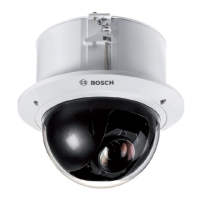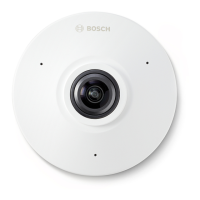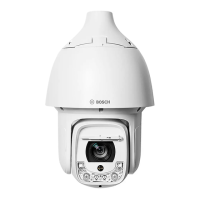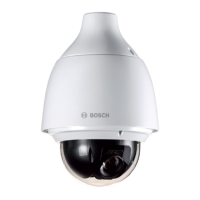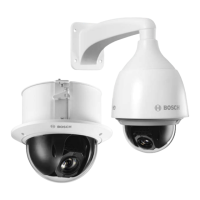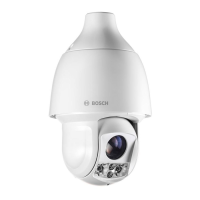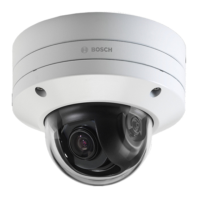
Do you have a question about the Bosch AUTODOME IP starlight 7000i and is the answer not in the manual?
| Digital Zoom | 12x |
|---|---|
| Sensor Type | CMOS |
| Low Light Performance | Starlight technology |
| Pan Range | 360° continuous |
| Ingress Protection | IP66 |
| Impact Protection | IK10 |
| Video Compression | H.265, H.264, MJPEG |
| Lens Type | Varifocal |
| WDR | 120 dB |
| Power | PoE+ |
| Operating Temperature | -40°C to +60°C |
| Focal Length | 4.3 to 129 mm |
| Aperture | F1.6 to F4.7 |
| Minimum Illumination | Color: 0.0077 lx; B/W: 0.0008 lx |
| Day/Night | Yes |
| Network Interface | RJ45 10/100/1000 Mbps |
| Frame Rate | 60 fps |
Lists hardware and software needed to operate the camera.
Details connecting the camera to a network via web browser or Project Assistant.
Explains setting and using strong passwords for secure camera access.
Describes the live video stream display and unit control.
Explains how to play back recorded video sequences.
Details how to configure the unit and application interface settings.
Explains that the Dashboard page displays detailed device information.
Covers naming, IDs, and stream descriptions for identifying the device.
Manages passwords, certificates, and active directory for secure user access.
Configures date, time, time zone, and daylight saving time for accurate recording.
Describes adding text, time, logo overlays, and configuring regions for video image.
Details parameters for GB/T 28181 national standard conformance for video monitoring systems.
Customizes web interface, logos, language, VCA metadata, and latency.
Adapts LIVE page functions like stream transmission, lease time, and auto logout.
Covers sensor mode, coding, orientation, SC settings, and device reboot.
Explains camera positioning, perspective, and calibration methods like sketch.
Optimizes image parameters via scene modes and custom configurations.
Adjusts color, exposure, gain, shutter, and AE response for image quality.
Adjusts sharpness, noise reduction, and HDR based on scene modes.
Schedules scene modes for day and night operation based on time ranges.
Configures video signal encoding, dual streaming, and pre-programmed profiles.
Manages stream prioritization, coding standards, and VCA overlays.
Identifies current stream, zoom factor, and averaging period.
Configures encoding regions for quality control and bit rate management.
Blocks specific scene areas from viewing or monitoring to enhance privacy.
Adjusts focus, focus speed, IR correction, and day/night near limits.
Manages auto pan speed, inactivity periods, sectors, and auto pivot features.
Defines preset scenes and creates tours for automated camera movements.
Saves settings for pre-positions, configures auto exposure, and sets day near limit.
Maps functions to pre-position actions for Bosch and non-Bosch protocols.
Explains how to define titles for specific sectors.
Covers fast address settings for camera identification in control systems.
Configures audio gain, line output, recording format, and input volume.
Displays pixel counts for checking function requirements and measuring objects.
Explains recording to iSCSI/SD cards, tracks, and profiles for image capture.
Manages storage media, including iSCSI and local SD card configurations.
Defines recording characteristics for profiles and assigns them to schedules.
Sets the duration for which recordings are retained before overwriting.
Links recording profiles with specific times/days, including holidays.
Displays recording activity, status, profile, zoom, and averaging period.
Configures JPEG image size, file naming, and VCA overlays for posting.
Configures camera response to alarms, including IP connections and transmission protocols.
Covers VCA setup, scenarios, analysis types, and tamper detection basics.
Masks scene parts for Intelligent Tracking to ignore background motion.
Configures audio alarms based on signal strength and frequency to avoid false triggers.
Sets up email notifications for alarms, including server details and format.
Configures alarm triggers, including contact types (NC, NO, NCS, NOS).
Configures relay operation modes and output names for alarm events.
Allows editing alarm functions via script for advanced automation.
Defines rules for inputs to activate outputs, specifying triggers like video analytics or time.
Lists and allows activation/deactivation of available network services.
Configures IP assignment, subnet mask, gateway, DNS, and video transmission.
Enables and configures DynDNS for internet access using a host name.
Configures cloud-based services and their operation modes.
Configures SNMP traps and UPnP communication for network monitoring.
Enables multiple receivers for simultaneous video signal reception using multicast.
Configures FTP or Dropbox accounts for posting and recording export.
Configures filters to allow or block network traffic based on IP address or protocol.
Covers firmware updates, progress monitoring, upload history, and configuration downloads.
Manages SSL/TLS certificates for secure communication.
Configures event logs, software sealing, and runs built-in self-tests.
Provides informational status details for technical support.
Selects camera streams (1, 2, M-JPEG) for live viewing.
Manages camera movement and image adjustment via pan, tilt, zoom, iris, and focus.
Displays and stores pre-defined camera positions (scenes) for quick recall.
Enters pre-programmed keyboard commands for various device functions.
Controls camera object tracking based on IVA rules or user selection.
Accesses functions like 360° scan, autopan, tour playback, and home position search.
Manages recording status, saving snapshots, recording live video, and full-screen display.
Enables audio communication and displays system status icons for storage, CPU, and network.
Interprets status icons for errors, alarms, communication, gaps, watermarks, and motion.
Shows IP addresses of connected devices and the current date/time ticker.
Provides instructions to start the Video Security app.
Selects recording streams, searches recorded video, and exports video tracks.
Uses time bar and controls for navigating and playing back recorded sequences.
Lists topics shown on the Dashboard page: Device status, Recording status, Connection status, Services.
Explains how to activate and use Intelligent Tracking, including IVA and user selection modes.
Provides guidance on recommended applications and usage scenarios for the camera.
Lists common issues like no video, dim image, or poor contrast, with troubleshooting steps.
Explains when and how to use the hardware reset button to restore factory defaults.
Lists status codes for PoE power, ambient temperature, and housing integrity.
Lists AUX commands with functions and descriptions for camera control.
Provides links to support services, apps, tools, warranty, and troubleshooting.
